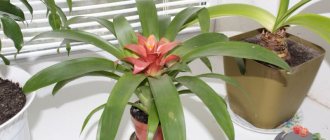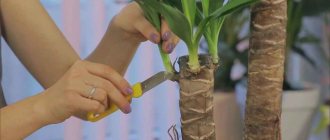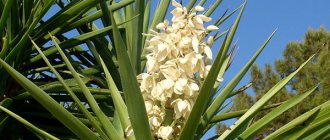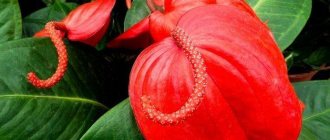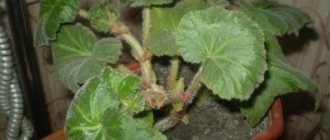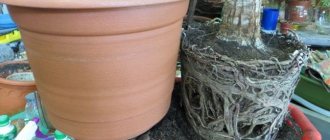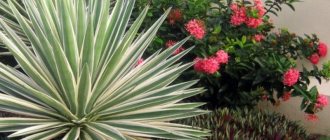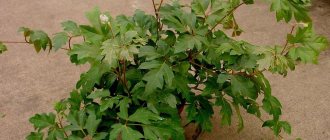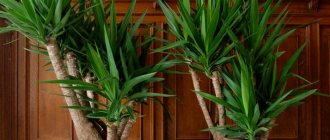Very often in garden plots you can find a beautiful evergreen ornamental plant with sword-shaped leaves and delicate inflorescences, delighting its owners with long-term flowering. This is a garden yucca - a resident of tropical countries, which has taken root well in the middle zone with cool climatic conditions. There are several dozen varieties of this unpretentious plant, each of which has its own characteristics of care. Having learned some of the secrets of planting and growing yucca, every gardener will be able to decorate their plot with this original and beautiful plant.
Yucca in open ground, varieties of wintering yucca in open ground
Not so long ago, yucca was grown exclusively in pots, enjoying fresh air only in the warm season, decorating it only on balconies and summer terraces. Over time, the number of varieties increased, and many gardeners began to plant this exotic flower in open soil. Some varieties are quite cold-resistant and can withstand temperatures below 20C. With proper care and shelter, the yucca is not in danger of dying, and with the onset of warmth it again delights passers-by with its snow-white clusters of bells.
Among the most cold-resistant varieties, the following are worth noting:
- Yucca filamentosa;
- yucca glaucous;
- elephant yucca.
Yucca flower description. Photo
Yucca is not a palm tree, although it is very similar to it. Previously, the Yucca genus was classified as a member of the Liliaceae family. Now it is assigned to the agave family. It includes approximately 50 species. They grow wild in Mexico and the southern states of the USA. Yucca garden, like cacti, is an indispensable attribute of the landscape of the Mexican prairies. These are plants accustomed to arid climates and sandy rocky soils.
Their exotic appearance, reminiscent of a palm tree, is given by low-branched stems with plumes of long, sword-shaped leaves. It is to the green lush sheaves on high trunks that yuccas owe their other name - bunch-nosed plants.
The flowers are collected in tall, showy inflorescences. In preparation for flowering, the plant throws out from the center of the leaf rosette powerful, tall (up to two meters), spreading panicles of bell-shaped flowers up to 7 cm long, somewhat reminiscent of huge chestnut inflorescences. The yucca's long, serrated leaf ends in a sharp, single spine. The height of the yucca trunk can reach twelve meters.
There are also stemless varieties that form rosettes of leaves directly on the ground. On yucca trunks, scars from the petioles of dead leaves remain for a long time. The fruit of yucca is a juicy capsule (multi-seeded berry). The plant is pollinated exclusively by yucca moth. Therefore, when propagated in culture, artificial pollination is needed to set seeds.
Yucca garden planting and care
An evergreen plant is characterized by unpretentiousness and the absence of any special growing conditions. With proper planting and attention, the plant will become an extraordinary decoration of any garden, giving the flower garden attractiveness and uniqueness. Yucca is very responsive to fertilizing, watering and loosening the soil. It can grow in one place for about 10 years, and sometimes more. You should especially carefully care for the flower in the first 2 years after planting, since during this period it develops and gains strength.
It is recommended to place the plant away from paths, since if the leaves are handled carelessly, cuts may appear on the skin, especially of children. Yucca is a wonderful decoration for any flower garden, and develops normally both alone and in the company of other ornamental plants.
Before planting in open soil, only the purchased plant needs hardening. This will allow him to better adapt to new conditions and contribute to more active development. To do this, you should take the yucca out into fresh air for 1-2 hours, gradually increasing the stay time by 1-2 hours for 10 days. Only after this is it recommended to plant the plant in the flower garden.
Complete care of any variety of yucca includes watering, fertilizing and shelter for the winter. Some gardeners trim old leaves to stimulate the growth of a new rosette and the timely appearance of a peduncle.
What does the flower look like?
Yucca is an evergreen tree-like flower with a low stem, at the top of which there are leaves that look like a panicle. They grow in a spiral, which gives the impression that the flower does not have a stem. Some species grow with a branched stem.
Description of the flower:
At home, the flower reaches a maximum height of no more than 2 m . In this case, the lower leaves gradually fall off and only the apical part remains. In nature, in natural conditions it reaches 4 meters.
The following photo shows what Yucca looks like:
What does yucca like:
Unpretentious and resistant to various diseases, yucca, if located in a favorable location, will reward you with lush flowering and the formation of new children, which will increase the family of a beautiful evergreen flower.
sun, shade or partial shade
Yucca prefers well-lit, sunny places, protected from windy weather and drafts. After planting, experienced gardeners recommend providing the plant with shade or partial shade for some time to ensure faster rooting of the underground part of the plant. Further growth of yucca in the shade can adversely affect its appearance, including yellowing and wilting of the leaves.
what kind of soil does yucca like?
Heat-loving yucca grows well in higher elevations with sandy soil. If the site is dominated by clay or black soil, it is recommended to add some sand when planting. It is recommended to enrich acidic soil with lime or dolomite flour. This will improve air exchange and moisture permeability, which is very important for the root system of the plant. Unfavorable places for garden yucca are loamy and marshy soils.
water for yucca, how to water
Yucca is responsive to timely watering, especially in the hot season. The main thing is to avoid excess moisture, as this can lead to rotting of the underground part of the bush. The lack of moisture affects the condition of the leaves - they begin to curl and dry out. Watering should be done in the evening or in cloudy weather, alternating with spraying the foliage of the plant from a spray bottle.
groundwater and yucca
The tropical plant does not like excessive moisture, therefore, the deeper the groundwater is located from its roots, the better for its growth. If the plant is planted in a lowland, it is at risk of washing away the roots and developing fungal diseases. In such cases, it is better to equip an artificial elevation by additionally adding sandy soil and fertilizing it.
feeding for yucca throughout the season
During the period of active growth, garden yucca needs regular feeding, which will ensure a complete supply of the necessary chemical elements for its development. Mineral fertilizers and compost are perfect for this. For adult yucca, it is useful to add organic matter in liquid form in early spring. During the period of bud formation, it is recommended to fertilize yucca with superphosphate.
Planned plant replanting
A planned replanting is carried out if you see that the soil is depleted. It becomes more dense in structure, after watering it begins to silt, and the plant stops (slows down) in development. The size of the pot can be increased or left the same.
You can tell that it’s time to replant the plant by other signs:
- the roots are cramped and they crawled out into the drainage hole;
- water became less absorbed;
- Due to the large size of the plant, the pot became unstable.
Timing and frequency of transplantation
Yucca grows slowly, so it is not often replanted - once every 2-3 years.
The most suitable time for this is the beginning of spring. Around the end of February, the plant comes out of dormancy - the roots begin to more actively absorb nutrients and moisture, and new leaves appear. It is important to correctly guess the moment when these processes are just beginning.
From late October to November, it is better not to touch the yucca. Even if you do not lower the winter temperature to 10–14⁰ C, relative peace still occurs. The roots slow down absorption, the vegetation mass does not grow, and the buds are dormant.
We discussed what kind of soil and pot are needed in the previous section. For planned transplantation, these requirements remain the same.
How to transfer a plant?
If the land is severely depleted, it is better to remove it as much as possible; no, use transshipment. This method allows for less trauma to the root system, it will recover faster, and as soon as you start feeding, it will begin to grow.
Place drainage at the bottom of the planting container and a small layer of soil on top. Place the plant along with the earthen ball in the center, fill the free space with fresh substrate, making sure that there are no air pockets left.
Before planting your yucca in a new pot, carefully inspect the roots. They should be light and elastic. Everything that has turned black, rotted, or become moldy needs to be cut off.
Reproduction of garden yucca
Depending on the variety, yucca can be propagated by cuttings or by dividing the bush. With normal development and proper care, over time, children appear at the base of the bush, most of which have a root system. Layers with roots take root well when transplanted, and bloom the next year.
A more labor-intensive way to propagate garden yucca is to prepare planting material from the root of an adult plant . To do this, you need to cut cuttings about 10-12 cm long and plant them in a container with soil consisting of peat and sand.
To stimulate the awakening of dormant buds, it is necessary to provide a sufficient level of moisture and heat. In the spring, this procedure can be carried out in a greenhouse, which will allow the plant to quickly adapt to climatic conditions and soil characteristics.
The plant is also propagated using the stem. To do this, you should separate part of the trunk near the root collar and dry it. Then place part of the stem horizontally in a container with wet sand and cover it with glass to create a greenhouse effect. With regular moisture, sprouts will soon appear on the stem. Then part of the stem with the sprout must be cut off and planted in the ground.
Transplantation with pruning
This option is used in the following cases:
It is recommended to cut the trunk when it reaches a diameter of 5 cm or more. The cutting height is at least 50 cm from the base. This is done with a sharp pruner or knife in one movement. The cut is dried and then disinfected. To do this, rub it with charcoal or activated carbon, cover it with garden varnish, pour it with melted paraffin - choose what suits you best.
Many people are interested in whether it is possible to trim and immediately plant yucca. Yes, that's exactly what they do.
Planting a trunk with roots
What to do with the top?
The top is also not thrown away. Part of the lower leaves (the bud of a new trunk) is removed from the rosette, the sections are dried and planted for rooting.
A small pot or plastic glass is suitable as a planting container. The soil is prepared lightly - from peat, perlite and sand in equal parts. Before planting, it is slightly moistened.
Until the roots appear, keep the planted top in conditions of high humidity.
How to use the remains of the trunk?
The rest of the trunk is cut into fragments 20–25 cm long and lightly sunk flat into a damp substrate for rooting. Place the dishes with the pieces in an improvised greenhouse, for example, a transparent plastic box, and wait for the axillary buds to awaken.
Reproduction of garden yucca by dividing the bush
Dividing a bush is the most common method of propagating an evergreen plant, which is used by both beginners and experienced gardeners. The main thing to pay attention to when separating a daughter rosette is the presence of roots. This guarantees normal development of the future bush and rapid rooting.
To propagate garden yucca using this method, it is recommended to follow a certain order:
- Use a sharp knife to separate the side young rosette from the main bush;
- To avoid the spread of infection, the sections must be dried and sprinkled with ground cinnamon;
- when dividing the bush in autumn, the plant needs to be planted in a small greenhouse; in the spring, the cuttings are planted immediately in a permanent place in open ground, ensuring timely irrigation and fertilizing;
- With the onset of cold weather, it is necessary to insulate the yucca using dry foliage and film cover.
Types and varieties
There are over thirty different species of Yucca. They differ mainly in leaves and sizes. Some species have lanceolate leaves, while others have sword-shaped leaves. In addition, the edges of the leaf blades in some species are covered with long, stiff hairs, in others - with spines, and in others they are smooth. In addition to the usual green leaves, indoor varieties of Yucca have variegated leaves with bright white or yellow stripes. The most popular types: filamentous, ivory, gray, glorious and aloel.
At home, mainly two types are grown - ivory and aloe vera. Less often - filamentous and blue. We are sure that all types of this plant will decorate your home. Let's get to know them better.
Yucca elephantipes
It is named so because of the wide, massive base of the stem, which appears in Yucca in old age, which resembles the foot of an African elephant. This species of Yucca is very unpretentious to living conditions. It grows slowly. It is accustomed to the arid climate of a city apartment, is undemanding to the soil composition and does not take up much space in the room. In addition, other indoor flowers that are resistant to dry soil, for example, indoor Geranium or decorative Kalanchoe, can be planted in a wide pot with Yucca. Against the background of Yucca, pots with Anthurium, Spathiphyllum, and Benjamin ficus look great. Dollar or Money trees will also decorate this floral arrangement.
This may be interesting: Description of types and varieties of Tradescantia
Yucca filamentous
In the south of Russia, in Crimea and the Caucasus, it grows in open ground and does not require shelter for the winter. In central Russia it is grown with shelter. Sometimes grown at home. This almost stemless plant grows as a shrub with beautiful bluish-green leaves, which have characteristic white or yellow stripes. The length of the leaves reaches 70 cm, width – up to 4 cm. The apex is pointed. The edges of the leaves are slightly drooping and contain numerous twisted white threads. The root system is well developed. The peduncle is very large, rising above the rosette to a height of up to one meter. Yucca blooms with drooping yellowish-white flowers up to 8 cm in length.
Yucca aloelia Marginata
This species is less common in indoor floriculture. It is more demanding in terms of content and takes up more space. It grows slowly, but over time, as it grows, the adult plant takes the shape of a ball with wide, leathery leaves. In the summer, Yucca Marginata blooms. On an inflorescence up to 45 cm long, many bell-shaped flowers of a creamy white color with a light purple tint are formed.
Yucca glauca
This type of Yucca has a greatly shortened stem. It does not grow higher than two meters in height. The bluish-green leaves are collected in dense rosettes about 90 cm wide. They are leathery, fibrous, up to 60 cm in length. At the edges they are white or gray with flaking fibers. In summer, it forms a paniculate inflorescence up to one meter in height, on which many small creamy-white flowers with a greenish or brown tint appear.
Yucca garden in the fall, how to prepare yucca for wintering
Today, there are many varieties of garden yucca, which normally tolerate lower air temperatures during the cold season. But in order to reduce the risk of plant death, especially if it has recently appeared on your site, you should take care of reliable insulation:
- Gather the leaves of the plant into a bunch and carefully tie it with twine, starting from the base of the bush and ending with the top.
- Wrap the plant with film, securing it at the base.
- To protect the roots, sprinkle 10-15 cm of soil at the base of the bush.
- On top of an earthen rampart in the northern regions, it is better to insulate the plant with spruce branches or dry leaves, which must be removed with the arrival of spring warming.
When to open yucca in spring
The winter shelter is removed from the plant with the onset of warm weather. In the middle climate zone, this is the second or last ten days of March. If the air temperature warms up during the day and the nights are quite cool, it is better to open the plant only during daylight hours. When the daily air temperature stabilizes and the likelihood of frost decreases, the plant can be opened completely. Often, most gardeners do this in early April.
How to feed yucca in spring
With the onset of spring warmth, the tropical plant begins an active growth phase, which requires additional nutrients. At this stage, it is recommended to fertilize yucca with complex mineral preparations, which are used for succulents.
If the plant was planted in the spring, then fertilizing must be done no earlier than after 14 days. To do this, fertilizers are used that stimulate the growth of the root system and accelerate the adaptation of the plant.
When will yucca bloom?
Garden yucca often blooms 3 years after planting, but under favorable conditions, beautiful inflorescences may appear the next year after rooting. White bells decorate the peduncle for 2-3 weeks, and in some cases for a whole month. For long-term flowering of yucca, it is important to provide favorable conditions - complete fertilizer, sufficient moisture and lighting.
Choosing a pot
For the plant, you should choose a clay or ceramic pot with a large hole for water drainage.
In clay or ceramics, the soil dries out almost evenly , so in a pot made of such material there will be no waterlogging of the soil, which will contribute to rotting of the plant root.
But yucca can also grow in plastic, provided there are one or more large drainage holes. In a plastic pot, the plant needs to be watered less often.
The diameter of the new yucca pot should be 2-3 cm larger than the transport one. The root system should fit in it and not touch its walls.
Is it possible to speed up the flowering of yucca
If all care conditions are met, garden yucca can delight you with snow-white tassels as early as next year. To do this, it is necessary to provide it with adequate nutrition with nitrogen fertilizers in the spring, water it in a timely and moderate manner, and also ensure loosening the soil and weeding out weeds that prevent the flow of nutrients to the root system.
To protect the top layer of soil from drying out, which can adversely affect the plant, it is recommended to mulch the soil with peat, or decorative crushed stone if the yucca is part of a rockery or alpine hill.
When is it better to plant yucca in spring or autumn?
Since the active growth phase of yucca begins in the spring, experienced gardeners recommend planting the evergreen plant in April-May. The plant requires consistently warm weather to acclimatize, so autumn is not a suitable time to plant the plant. It may simply not take root before the onset of cold weather and die. If there is a need to plant yucca due to the appearance of additional rosettes, the deadline for planting the plant in the middle zone is the end of summer.
